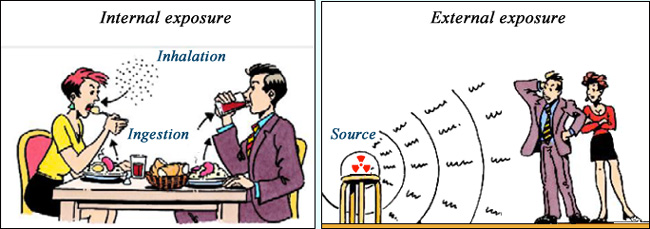How to protect oneself from radioactivity?
Our fear of radiation dates back to the early 20th Century, when many of the early experimenters with radioactivity started to feel its negative consequences. The initial enthusiasm that had surrounded the discovery of radioactivity waned as high doses were discovered to be fatal to humans. Much later, in 1945, the use of the atomic bombs on Hiroshima and Nagasaki clarified the enormous risks that a misuse of nuclear fission could entail. The 1986 Chernobyl disaster also did much to prejudice us against this powerful natural phenomenon.
Our fear is inextricably tied up with the mysterious and insidious nature of these invisible rays. They are not directly painful, and the cancers and tumours they can cause generally take years to develop. In fact, it is only in cases involving very high doses that cancer can be linked to a specific case of overexposure. For much more smaller and common exposures, effects are also small and difficult to measure: the link between the cause and the effect is as yet unproved.
Fears are often amplified by a deep ignorance of radiation effects. The consequences of this ignorance can be dramatic after severe accidents. For instance after Fukushima, the anxiety of being contaminated, of getting a cancer, the evacuations trauma have led to a number of deaths surpassing by far the deaths caused by radiations ! « Fukushima: Is fear of radiation the real killer? » is the title of an interesting BBC report published three years after the accident.
It is not at first sight confidence-inspiring to know that a large number of questions about radioactivity can not still be answered precisely. What is the exact relationship between exposure and risk? Is there a threshold below which radiation is truly harmless? In all such cases and for all such questions, there is no clear answer. The effects of exposure to radiation depend heavily on the nature of the exposure, which organs were exposed, and the general health of the person at the time of the incident.
In order to set up levels permissible for living beings, it is of importance to define doses of exposure which take into account the sensitivity of the whole human body, and of a particular organ in medicine. In case of accident, these doses and their effects are very difficult to evaluate afterwards.
This is precisely where radioprotection comes in. Radioprotection is the study of the risks resulting from exposures to radioactivity and more generally to radiations, and the basis of all our attempts to minimize them. Over the last hundred years, the field of radioprotection has devised regulations and specific safety procedures. The fundamental principle of precaution is that the potential risk may be never zero (an undoubtedly pessimistic supposition) and that it should be minimised as much as possible.

Internal and external exposures
Exposures due to the ingestion or inhalation of radioactive atoms ; Exposure due to an external source of radiation.
© CEA
ACCESS TO CHAPTERS : SUMMARY
– Radiation effects : Effects on living tissues ; relationship between exposure and consequences ; radioactive toxicity.
– Doses of radiations : Activities and becquerels. Energy deposits and grays. Biological doses : equivalent, effective doses and millisieverts. Radiation doses
– Types of exposures : Internal exposures, contact exposures and external exposures
– Radioprotection : Radioprotection principles and techniques. Doses limits. Protections against gamma and neutrons. Decontaminations.
– Case of major accident : Expositions after a major release. Post-accident radioprotection measures.
– Dosimetry : Measuring doses and dosimeters